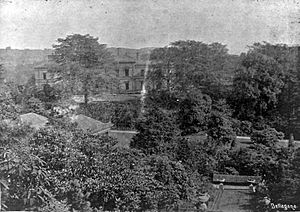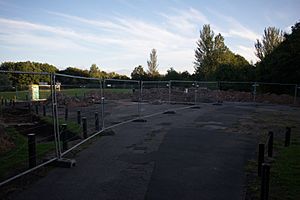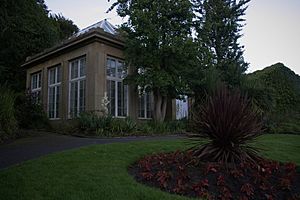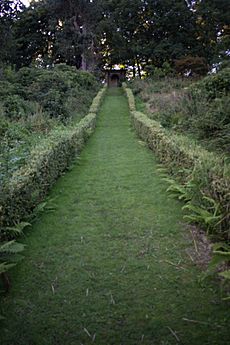Philips Park, Prestwich facts for kids
Philips Park is a beautiful area of parkland in Greater Manchester. It's located between Whitefield and Prestwich. The park is full of amazing trees and plants, and lots of different animals live there.
A big part of the park used to be the home of the Philips family. The rest of the land, called Waterdale, was once used for factories that cleaned and dyed cloth. After these factories were taken down, the land became part of the park. Philips Park is now a special local nature reserve, which means it's protected for its wildlife and natural beauty.
The park also has the Barn Countryside Centre. This centre often holds fun events for everyone, like workshops where you can learn to weave with willow or make pottery. You can also try pond dipping to see what creatures live in the water, or learn about how to look after woodlands.
Contents
Park History
Philips Park is named after the Philips family. They owned this land for a very long time, from 1799 until 1948. The land was originally part of a medieval deer park called Pilkington Park.
Robert Philips, who owned a textile company called J. & N. Philips, bought the land in 1798. Robert and his wife Ann had two sons, Mark Philips and Robert Philips, who both became politicians. They also had nine daughters.
The Philips family built many of the buildings in the park. They also kept some of the natural features, like the old woodlands called North Wood, Mid Wood, and Mere Clough. There was also a medieval deer pale, which was a fence that marked the park's southern and eastern edges.
Mark Philips, a politician from the Liberal Party, was born in the park on November 4, 1800.
The Philips family lived in the park until Robert Philips' granddaughter, Anna Maria Philips, passed away in 1946. After that, the park was sold to the local councils of Whitefield and Prestwich. It officially opened as a public park for everyone to enjoy in 1948. Many items from the family's home were sold in an auction. For example, a Georgian mahogany dining room sideboard made by Robert Gillow was sold for £6.
In 1971, the M62 motorway was built. This construction changed a large part of the North Wood valley.
Park Buildings
The Philips Family Home
The Philips family's main home was finished by Robert Philips in 1830. It was built in a beautiful Italian villa style. The house was placed near a steep bank, which helped protect it from the cold north winds. The front of the house looked grand, and the back faced a lovely lawn.
Sadly, the house became very old and broken down. It was taken down in 1950. Today, the area where the house once stood is now a car park. You can still see some of the old foundations of the building there.
Originally, you could get to the park from Park Lane. In 1852, a large bridge called a viaduct was built. This allowed horse-drawn carriages to drive directly from Bury New Road, along Philips Park Road, to the park. This viaduct later became unsafe and was closed. In the 1960s, the Royal Engineers used a controlled explosion to take it down.
Outwood Lodge
Outwood Lodge was another home in the park. It belonged to John Grundy, who was in charge of the East Lancashire Railway. Later, Mark Philips lived there. This lodge overlooked the North Wood. It was later replaced by the North Lodge around 1890–1900. Today, only a small part of a wall from Outwood Lodge remains near the North Lodge.
North Lodge
The North Lodge is located where Philips Park Road meets Park Lane. This building replaced Outwood Lodge, and some parts of the old lodge were used to build it. The North Lodge was used as a home for staff members until Anna Maria Philips passed away in 1946.
Philips Park Road Viaduct
This large bridge, or viaduct, was built in 1852. It cost £8,000 to build. It had eight brick arches that stretched across the valley, about 80 feet (24 meters) below. Robert Philips, the Earl of Derby, and the East Lancashire Railway all helped pay for it.
The viaduct made it easier for coaches to travel directly between Bury New Road, the park, and Molyneux Brow railway station. There was a path under the viaduct that led to Mere Clough. At one point, the Earl of Derby's agent tried to block this path. However, a legal case decided that the path should remain open.
By 1965, the viaduct was in very bad condition. It was taken down in November of that year. Today, the M60 motorway follows the same path where the viaduct once stood. Because of the motorway, there is no longer any sign that the viaduct was ever there.
Philips Park Lodge (Witch's Cottage)
Philips Park Lodge was a small, charming cottage with a thatched roof. It was built in the style of the Regency period. People in the area often called it the "Witch's Cottage." For a while, it was left uncared for and was even set on fire by vandals. It was taken down in 1969 to make way for the M62 motorway.
South Lodge
The South Lodge was built around the same time as Philips Park Lodge. It looked out over a small lake east of Molyneux Brow railway station, along an old path used by packhorses. Even in the 1960s, this house had no gas or electricity. Even though it was a protected historic building, it fell apart and was taken down in 1974.
Thatched Cottage
The Thatched Cottage was the first entrance lodge to Philips Park. It was built next to a driveway lined with trees. This cottage was replaced in the early 1900s by the North Lodge, but it wasn't built in the exact same spot. This cottage was also taken down in 1968 to make way for the M62 motorway.
The Stables
The Stables building was once a nightclub. Now, it is being restored to look like it did before the 20th century. This means that all the parts added for the nightclub are being removed. This has revealed the original courtyard, which had been hidden. A grant from the Heritage Lottery Fund has helped with this restoration project.
Park Features
The Conservatory
The Conservatory was built with ashlar sandstone shortly after 1800. It has large rectangular windows and a central triangular part called a pediment. Its glass roof has a round light at the top. This building is a Grade II listed building, which means it's an important historic structure. Inside, there was a beautiful bronze fountain from Florence, Italy, placed in a mossy area. Below the conservatory, there is a lily pond.
Grass Walk
The Grass Walk was a staircase made of grass. It led up to a Garden Temple. This temple originally held a marble statue that was carved in Rome in 1856.
What's Happening Now?
Some of the original buildings in Philips Park are still standing today. These include the Grade II listed North Lodge and the Grade II listed Conservatory. The Park Hall and some of the staff accommodation and stables area also remain. The main house where the Philips family lived was taken down in 1950.
In 1998, Bury Council started a plan to restore the park, with money from the Heritage Lottery Fund. However, a year later, Philips Park was removed from the English Heritage Register of Parks and Gardens of Special Historic Interest in England because it had become run down.
Currently, there is a big plan to improve the park over five years, costing £4 million.
In 2009, a group called the Friends of Prestwich Forest Park received money. This money, along with funding from Bury Metropolitan Borough Council, was used to clear Cobster Field. This field used to be a large area of grazing land. It was meant to impress visitors as their carriages drove to the Philips' mansion. But when the M62 motorway was built, the field was covered with soil and started to turn back into woodland. The money was used to clear the field, plant new grass, and bring back the views down the Irwell Valley towards Manchester city centre.
How to Get There
You can drive to Philips Park by using Park Lane. This is northwest of Junction 17 of the M60 motorway. The North Lodge of the park is located at the corner of Park Lane and Philips Park Road. Park Lane crosses the motorway over a bridge. You can also get to the park by walking or cycling on the many old roads and trails around the park's edges.







